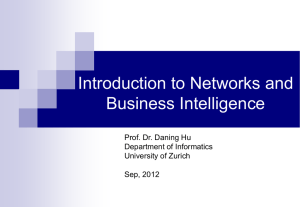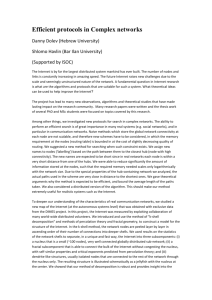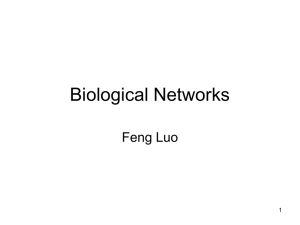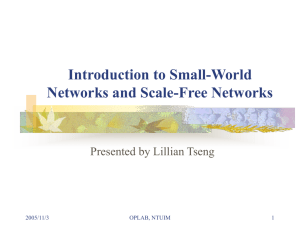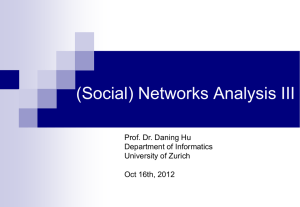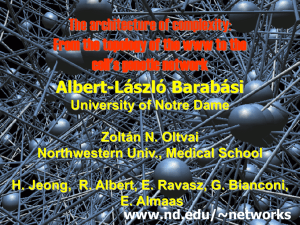Random networks - Weizmann Institute of Science
advertisement
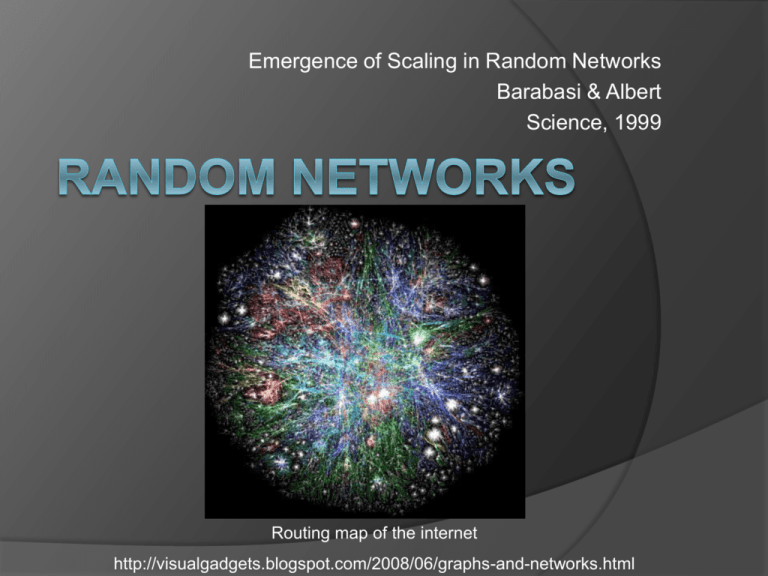
Emergence of Scaling in Random Networks Barabasi & Albert Science, 1999 Routing map of the internet http://visualgadgets.blogspot.com/2008/06/graphs-and-networks.html What is a network? A graph is : an ordered pair G = (V,E) comprising a set V of vertices or nodes together with a set E of edges or lines, which are 2-element subsets of V A set of elements together with interactions between them Representation: a set of dots connected with (directed) lines Where networks arise? Computer networks Internet, LAN, Token-ring, 1553 Biology Gene regulation, food chain, metabolic networks Data storage structures: WWW, data-base trees Power transmition Electric power grid, hydraulic transmition Social interaction Citation patterns, friendships, professional hierarchy Computation Flow field computation, stress field computation Internet routing map, 1999 http://www.cheswick.com/ches/map/ Power grid, USA, 2001 http://www.technologyreview.com/Energy/12474/page2/ Sexual / Romantic partners network Bearman, Moody, Stovel. Chains of Affection: The Structure of Adolescent Romantic and Sexual Networks. AJS, 2004 Jefferson High, Columbus, Ohio Metabolic network of E. Coli Organization chart Large-scale, “natural” networks How “random” are “natural” networks (WWW, internet, gene regulation, …) “natural” ~ no apriori structure defined What are the key characteristics of natural networks? What is “Random Network”? Random network – ensemble of many possible networks: Fixed or unfixed number of vertices (dots) Fixed or unfixed number of edges (lines) Any two vertices have some probability of being connected Key notion: node connectivity connectivity = number of connections First model – Erdos & Renyi, 1947 ER random network model Network model: a random network between n nodes: Fix the number of vertices to n For each possible connection between vertices v and u, connect with probability p P(rank=k) = ER random network model Features Every node has appr. same number of connections connectivity is scaledependent! l=l(N) Tree-like! Internet-like network evolution http://www.cheswick.com/ches/map/index.html http://www.cheswick.com/ches/map/movie.mpeg ER model and real life Real-life networks are scale-free: Connectivity follows power-law: P(k) ~ kγ γ = 2.1…4 ○ very low connection numbers are possible Actor collaboration WWW Power grid N=212e3, <k>=29, γ=2.3 N=325e3, <k>=5.5, γ=2.1 N=5e3, <k>=2.7, γ=4 ER model VS. Scale-free network ER: same average number of connections per node – treelike SF: hubs present – few nodes with large number of connections – hierarchy! ER model VS. Scale-free network Adjacency matrix A: Number the nodes from 1 to N If vp connected to vq , put 1 in apq 1 2 3 4 5 6 1 2 3 4 5 6 ER model VS. Scale-free network Adjacency matrix of ER: ~ uniform distribution of 1’s Adjacency matrix of SF: 1’s lumped in columns & rows for few nodes SF ER Barabasi model Goal: generation of random network with “scale-free” property 1. Number of edges – not fixed Continuous growth 2. Preferential attachment Prob. of a new node to attach to existing one rises with rank of node P(attach to node V) ~ rank(V) Barabasi Model Produces scale-free networks Scale-free distribution – time-invariant. Stays the same as more nodes added Barabasi Model Removal of either assumptions destroys scale-free property: Without node addition with time → fully connected network after enough time Without preferential attachment → exponential connectivity ER Vs. Barabasi Graph diameter: the average length of shortest distance between any two vertices For same number of connections and nodes, ER has larger diameter than scale-free networks No small-world in ER! Scale-free Network features Network diameter Failure = removal of random node Attack = removal of highlyconnected node % of “damaged” nodes Robustness to random failure Susceptibility to deliberate attack Scale-free Network features “Small-world” phenomenon, or: “6 degrees of separation” Stanley Milgram, 1967, Psychology today Small-world experiment Experiment: send a package from Nebraska and Kansas (central US) to Boston, to a person the sender doesn’t know Motivation: great distance – social and geographical Only 64 of 296 packages were delivered For delivered packages: average path length ~ 6 Google search Brin & Page, 1998; Kleinberg, 1999 Pages are ranked according to incoming links Incoming link from a high-score page is more valuable Meaning: after random clicks, a user will be on high-ranked page Prefers old, well-connected pages Google search Erdos & Bacon Number Erdos number: “collaborative distance” of a mathematician from Paul Erdos Average: ~6 Kahenman, Auman: 3 Bacon Number: “collaborative distance” of an actor from Kevin Bacon http://oracleofbacon.org/ Average: ~3 Summary Many real-life, large-scale networks exhibit a scale-free distribution of connectivity Distribution is power-law Similar powers for networks of different types Small-world phenomenon Key features to enable free-scale property: Addition of new nodes Preferential attachment




